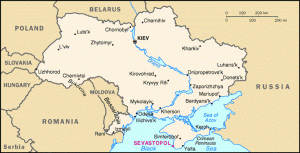Students know of the widespread devastation that resulted from WWII, but most history lessons stop just short of how those countries, cities and towns picked up the pieces and rebuilt their homes. As this reading shows, it wasn’t an easy task. Sevastopol needed to be completely rebuilt–and not just the buildings, but social services as well. Infrastructure was close to nonexistent, public health services were failing the population and all the while, architects and city planners were attempting to “russify” the Ukrainian city with a city-wide face lift in the Russian style.
In typical Soviet Union fashion, the state wanted Sevastopol to be rebuilt in the Russian image. As Professor Qualls wrote in his article, “the perceived reversion to tradition meant a Russian ethnic identification wrapped in a Greek architectural façade, yet devoid of all hints of competing identifications.” When I read this, I was completely unfazed. Why of course the government would use this opportunity to impose Russian culture on Sevastopol. It would be logical for the people of Sevastopol to want to rebuild their own heritage, commemorate their losses in their own fashion and construct a city of their own choosing–but this wasn’t an option under Soviet rule.
It was this “top-down” approach to reconstruction that most caught my attention in the article, but the health and safety conditions plaguing the city were of great importance as well. It took several years before disease began to decline, living conditions (such as apartments with adequate space so as not to spread disease) improved, health services (such as ambulances) were restored and the population began to rebound. Of course, the important thing is that the city did achieve this stability, but I’m sure that if compared to the reconstruction timelines of Western European nations, the case of Sevastopol look quite bad.


This is ignorant anti-Russian bigotry. At the end of WW2 Crimea was part of Russia, not Ukraine. It was transferred to Ukraine only in the 1950s by Khrushchev out of guilt for what he had done to Ukraine when he was Ukrainian party secretary in the 30s. Sevastopol is, was and always has been a Russian city. Almost all of its inhabitants are still Russian speakers. The idea it was rebuilt to destroy its Ukrainian identity is rubbish. It never had a Ukrainian identity.
Mr. Antony,
Perhaps rather than uninformed flaming, you might read carefully and educate yourself on the topic. When my student writes about the Ukrainian city, she states the obvious…it is juridically part of Ukraine today. When she quotes me she is talking about erasing traces of the city’s Tatar and Jewish heritage, not Ukrainian. If you read my book, From Ruins to Reconstruction, which is the only book on the rebuilding of Sevastopol, you will see that there are no claims of erasing Ukrainian identity. Rather, the rebuilding process was focused primarily on reinforcing a pre-Soviet Russian heritage.
Having lived in Sevastopol, I would concur with you that it is a city that is overwhelmingly Russian, culturally and linguistically. And as I have written in numerous places, I don’t think that will change any time soon even though it has been part of Ukraine for over half a century.
So, next time you might want to engage in CIVIL discourse after you have informed yourself of the facts.